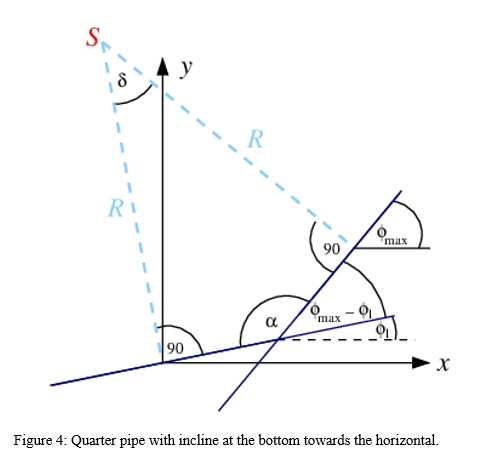Mathematics of skateboard quarter pipe construction
Keywords:
Transition geometry, Skateboardramp, Quarterpipe, Skateboarding, Skateramp constructionAbstract
The present article provides a detailed mathematical treatise on the geometry of skateboard transition ramps. These usually form a circular segment shape and are used in skateboarding for transitioning from a horizontal plane to another angle of incline. Transitions play a crucial role in the flow of skateparks and are required, for example, for quarter pipes, mini ramps, vert ramps, or jump ramps. Skateboarding has been an Olympic sport since 2023, yet many publicly funded skateparks still do not meet the demands of the sport. On one hand, there is often a lack of willingness from authorities to engage with the athletes beforehand; on the other hand, the people involved in the planning process often lack the necessary experience and mathematical expertise to perfectly fulfill the users' needs. Thoughtful planning is particularly crucial for ramps with curved surfaces to ensure the flow of the skatepark. In addition to the mathematical analysis, source codes for programs are provided to make the calculations as convenient as possible for all users.
Downloads
References
I. N. Bronstein: Taschenbuch der Mathematik, B.G.Teubner Stuttgart-Leibzig, 1996
T. Daskalov: Concrete skateparks - Design and construction of a skateboarding recreational facility, Bachelor’s thesis, Häme University of Allpied Sciences, 2015
B. Degros: Building a Mini-Ramp (Part 1) Choosing the Height and Radius, https://youtu.be/nfRWPDdMCg4?feature=shared, 2023
D. Poirier: Skate Parks: A guide for landscape architects and planners, Master thesis, https://books.google.de/books?id=2hAGkAEACAAJ, Kansas State University, 2008
W. H. Robertson, R. D. Meyer, T. L. Wilkerson: The Mathematics of Skateboarding: A Relevant Application of the 5Es of Constructivism, Journal of Education and Learning, Vol. 1, No. 2, 2012, ISSN 1927-5250 E-ISSN 1927-5269, Journal of Education and Learning, Vol. 1, No. 2, 2012
A. Vodopivec: wxMaxima 18.02.0. http://andrejv.github.io/wxmaxima/
C . Freeman, T. Riordan, “Locating Skateparks: The Planner's Dilemma”, Planning, Practice & Research, Vol. 17, No. 3, https://doi.org/10.1080/026974502200005682, 2002.
H. Woolley, R. Johns, “Skateboarding: The City as a Playground.”, Journal of Urban Design, 6(2), 211–230, https://doi.org/10.1080/13574800120057845, 2001.
Å. Bäckström, S. Blackman, “Skateboarding: From Urban Spaces to Subcultural Olympians.” YOUNG, 30(2), 121-131, https://doi.org/10.1177/11033088221081944, 2022.
I. Borden, “Skateboarding, Space and the City: Architecture and the Body”, Bloomsbury Publishing, 2001.
I. Borden, “The spaces of skateboarding”, Architects' Journal, https://www.architectsjournal.co.uk/practice/culture/the-spaces-of-skateboarding, 2014.
I. Borden, I. “Southbank skateboarding, London and urban culture: The undercroft, Hungerford Bridge and House of Vans.” In K. J. Lombard (Ed.), Skateboarding: Subcultures, sites and shifts (pp. 91-107). London, England: Routledge, 2016
K. Butz, C. Peters, “Skateboard Studies”, Koenig Books, ISBN 9783960983415, https://books.google.de/books?id=QzD4twEACAAJ, 2018.
S. Holsgens, “Skill Acquisition and Korean Landscape Architecture: An Ethnographic Account of Skateboarding in Seoul, South Korea”, Journal of Sport and Social Issues, DOI: 10.1177/0193723519832460, 2019.
B. Glenney, S. Mull, “Skateboarding and the Ecology of Urban Space.”, Journal of Sport and Social Issues, 42(6), 437-453. https://doi.org/10.1177/0193723518800525, 2018.
C. Chiu, “Contestation and Conformity: Street and Park Skateboarding in New York City Public Space.”, Space and Culture, 12(1), 25-42. https://doi.org/10.1177/1206331208325598, 2009.
P. Whitley, “Public Skatepark Development Guide: Handbook for Skatepark Advancement”, Skaters for Public Skateparks, ISBN 9780692000809, https://books.google.de/books?id=ppBttwAACAAJ, 2009.
M. Batuev, L. Robinson, “How skateboarding made it to the Olympics: an institutional perspective.”, International Journal of Sport Management and Marketing, 17 (4-6), pp. 381-402. https://doi.org/10.1504/IJSMM.2017.087446, 2017
D. Buckingham, “Skate Perception: Self-Representation, Identity and Visual Style in a Youth Subculture.” In: Buckingham, D., Willett, R. (eds) Video Cultures. Palgrave Macmillan, London. https://doi.org/10.1057/9780230244696_7, 2009.
K. Sorsdahl, et al. “Experiences and Perceived Benefits of a Youth Skateboarding Program in South Africa: From the Physical to Emotional and Beyond.”, Journal of Adolescent Research, 39(3), 770-795. https://doi.org/10.1177/07435584211052983, 2024.

Downloads
Published
How to Cite
Issue
Section
ARK
License
Copyright (c) 2024 Thomas Günther

This work is licensed under a Creative Commons Attribution 4.0 International License.
Copyright on any article in the International Journal of Engineering and Applied Physics is retained by the author(s) under the Creative Commons license, which permits unrestricted use, distribution, and reproduction provided the original work is properly cited.
License agreement
Authors grant IJEAP a license to publish the article and identify IJEAP as the original publisher.
Authors also grant any third party the right to use, distribute and reproduce the article in any medium, provided the original work is properly cited.














